Toyota Sienna Service Manual: On-vehicle inspection
| NOTICE: In this section, the terms "cold" and "hot" refer to the temperature of the coils. "Cold" means approximately - 10°C (14°F) to 50°C (122°F). "Hot" means approximately 50°C (122°F) to 100°C (212°F). |
1. INSPECT IGNITION COIL ASSEMBLY
(a) Check for DTCs.
| NOTICE: If any DTC is present, perform troubleshooting in accordance with the procedures for that DTC. |
(b) Remove the ignition coil assembly and spark plug.
(See page IG-8).
(c) Check that sparks occur.
(1) Disconnect the 6 fuel injector connectors.
(2) Install the spark plugs to each ignition coil, and connect the ignition coil connectors.
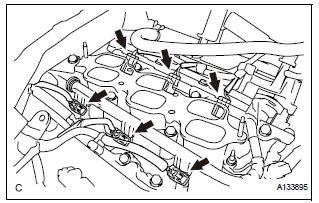
(3) Ground the spark plugs.
(4) Check if a spark occurs at each spark plug while the engine is being cranked.
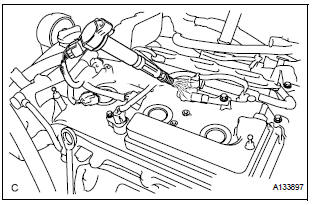
NOTICE:
|
(d) Perform the spark test according to the flowchart below.
(1) Check that the ignition coil connector is securely connected.
Result 
(2) Perform a spark test on each ignition coil.
1. Replace the ignition coil with a normal one.
2. Perform the spark test again.
Result 
(3) Check the spark plug (See page EM-1).
Result 
(4) Check the power supply to the ignition coil.
1. Turn the ignition switch to the ON position.
2. Check that there is battery voltage at the ignition coil positive (+) terminal.
Result
(5) Measure the resistance of the crankshaft position sensor (See page ES-514).
Result
(6) Check the IGT signal from the ECM (See page ES-233)
Result 
(e) Using a 16 mm (0.63 in.) plug wrench, install the spark plugs.
Torque: 18 N*m (184 kgf*cm, 13 ft.*lbf) (f) Connect the 6 fuel injector connectors.
(g) Install the ignition coil assembly (See page IG-10).
2. INSPECT SPARK PLUG
NOTICE:
|
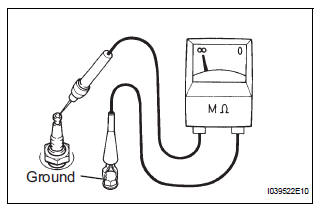
(a) Check the electrode.
(1) Using a megohmmeter, measure the insulation resistance.
Standard insulation resistance: 10 MΩ or higher
HINT:
- If the result is 10 MΩ or less, clean the plug and measure the resistance again.
- If a megohmmeter is not available, perform the following simple inspection instead.
(b) Alternative inspection method: (1) Quickly accelerate the engine to 4000 rpm 5 times.
(2) Remove the spark plugs.
(3) Visually check the spark plug.
If the electrode is dry, the spark plug is functioning properly. If the electrode is damp, proceed to the next step.
(c) Check the spark plug for any damage to its threads and insulator. If there is damage, replace the spark plug.
Recommended spark plug 
| NOTICE: Use only the listed spark plug or equivalent to ensure engine performance and smooth driveability. |
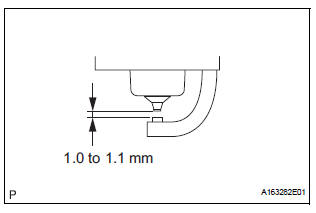
(d) Check the spark plug electrode gap.
Maximum electrode gap for used spark plug: 1.4 mm (0.055 in.) If the gap is greater than the maximum, replace the spark plug.
Electrode gap for new spark plug: 1.0 to 1.1 mm (0.039 to 0.043 in.)
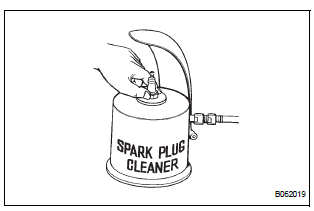
(e) Clean the spark plugs.
If the electrode has traces of wet carbon, clean the electrode with a spark plug cleaner and then dry it.
Standard air pressure: 588 kPa (6 kgf*cm2, 85 psi) Standard duration: 20 seconds or less
HINT: Only use the spark plug cleaner when the electrode is free of oil. If the electrode has traces of oil, use gasoline to clean off the oil before using the spark plug cleaner.
(f) Install the ignition coil assembly and spark plug.
(See page IG-10).
 Ignition coil and spark plug
Ignition coil and spark plug
Components
...
 Removal
Removal
1. DISCONNECT CABLE FROM NEGATIVE BATTERY
TERMINAL
2. DRAIN ENGINE COOLANT
3. REMOVE FRONT WIPER ARM HEAD CAP (See page
WW-4)
4. REMOVE FRONT WIPER ARM RH (See page WW-4)
5. REMOVE FRONT WIPER A ...
Other materials:
Inspection
1. V
(a) Inspect VSV operation.
(1) Using an ohmmeter, measure the resistance
according to the value(s) in the table below.V
Standard resistance
If the result is not as specified, replace the
vsv.
(B) inspect the vsv for ground.
(1) Using an ohmmeter, measure the resistance
accordin ...
Diagnostic trouble code chart
HINT:
If a trouble code is displayed during the DTC check,
inspect the circuit listed for that code. For details of the
code, refer to the "See page" in the DTC chart.
Inspect the fuse and relay before investigating the
suspected areas shown in the table below.
W ...
Removal
1. DISCONNECT CABLE FROM NEGATIVE BATTERY
TERMINALV
Caution:
wait at least 90 seconds after disconnecting the
cable from the negative (-) battery terminal to
prevent airbag and seat belt pretensioner activation.
2. Remove air fuel ratio sensor (for bank 2
sensor 1)
(a) ...
